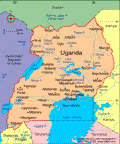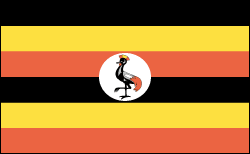Uganda
Facts & Figures

-
President: Yoweri Museveni (1986)
Prime Minister: Ruhakana Rugunda (2014)
Land area: 77,108 sq mi (199,710 sq km); total area: 91,135 sq mi (236,040 sq km)
Population (2014 est.): 35,918,915 (growth rate: 3.24%); birth rate: 44.17/1000; infant mortality rate: 60.82/1000; life expectancy: 54.46
Capital and largest city (2011 est.): Kampala, 1.659 million
Monetary unit: Ugandan new shilling
Republic of Uganda
Languages: English (official national language, taught in grade schools, used in courts of law and by most newspapers and some radio broadcasts), Ganda or Luganda (most widely used of the Niger-Congo languages, preferred for native language publications in the capital and may be taught in school), other Niger-Congo languages, Nilo-Saharan languages, Swahili, Arabic
Ethnicity/race: Baganda 16.9%, Banyakole 9.5%, Basoga 8.4%, Bakiga 6.9%, Iteso 6.4%, Langi 6.1%, Acholi 4.7%, Bagisu 4.6%, Lugbara 4.2%, Bunyoro 2.7%, other 29.6% (2002 census)
Religions: Roman Catholic 41.9%, Protestant 42% (Anglican 35.9%, Pentecostal 4.6%, Seventh-Day Adventist 1.5%), Muslim 12.1%, other 3.1%, none 0.9% (2002 census)
Literacy rate: 73.2% (2010 est.)
Economic summary: GDP/PPP (2013 est.): $54.37 billion; per capita $1,500. Real growth rate: 5.6%. Inflation: 6.2%. Unemployment: n.a. Arable land: 27.94% (2011). Agriculture: coffee, tea, cotton, tobacco, cassava (manioc, tapioca), potatoes, corn, millet, pulses, cut flowers; beef, goat meat, milk, poultry. Labor force: 17.4 million (2013 est.); agriculture 82%, industry 5%, services 13% (2011 est.). Industries: sugar, brewing, tobacco, cotton textiles; cement, steel production. Natural resources: copper, cobalt, hydropower, limestone, salt, arable land, gold. Exports: $3.156 billion (2013 est.): coffee, fish and fish products, tea, cotton, flowers, horticultural products; gold. Imports: $4.858 billion (2013 est.): capital equipment, vehicles, petroleum, medical supplies; cereals. Major trading partners: Kenya, Rwanda, Democratic Republic of the Congo, UAE, Netherlands, Germany, China, India, South Africa, Japan, Italy (2012).
Member of the Commonwealth of Nations
Communications: Telephones: main lines in use: 315,000 (2012); mobile cellular: 16.355 million (2012). Broadcast media: public broadcaster, Uganda Broadcasting Corporation (UBC), operates radio and television networks; Uganda first began licensing privately-owned stations in the 1990s; by 2007 there were nearly 150 radio and 35 TV stations, mostly based in and around Kampala; transmissions of multiple international broadcasters are available in Kampala (2007). Internet Service Providers (ISPs):32,683 (2012). Internet users: 3.2 million (2009).
Transportation: Railways: total: 1,244 km (2008). Highways: total: 20,000 km; paved: 3,264 km; unpaved: 16,736 km (2011). Waterways: there are no long navigable stretches of river in Uganda; parts of the Albert Nile that flow out of Lake Albert in the northwestern part of the country are navigable; several lakes including Lake Victoria and Lake Kyoga have substantial traffic; Lake Albert is navigable along a 200-km stretch from its northern tip to its southern shores (2011). Ports and harbors: Entebbe, Jinja, Port Bell. Airports: 47 (2013).
International disputes: Uganda is subject to armed fighting among hostile ethnic groups, rebels, armed gangs, militias, and various government forces that extend across its borders; Uganda hosts 209,860 Sudanese, 27,560 Congolese, and 19,710 Rwandan refugees, while Ugandan refugees as well as members of the Lord's Resistance Army (LRA) seek shelter in southern Sudan and the Democratic Republic of the Congo's Garamba National Park; LRA forces have also attacked Kenyan villages across the border.

